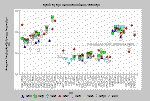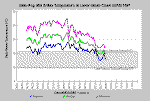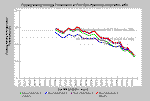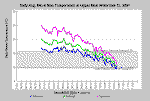Bibliography Background About KRIS
Hypothesis #3: Water temperature is limiting salmonid production in the mid and upper reaches of the mainstem Garcia River and several upper basin tributaries.
Support for the Hypothesis
Pacific salmon are cold water loving species and McCullough (1999) defined the optimal growth range for all salmonids as 10-15.6° C. Welsh et al. (2001) noted that coho salmon were absent in streams with a maximum floating weekly average temperature (MWAT) greater than 16.8° C. Sullivan et al. (2000) considered 26° C as the upper incipient lethal temperature for salmonids in the Pacific Northwest, although this does not indicate that all salmonids die if a stream attains that temperature for a brief duration.
Negative effects on salmonids may occur at much lower temperatures, such as impaired growth rates, decreased ability to compete with other species, and increased susceptibility to disease (Sullivan et al., 2000). Based on a review of steelhead growth studies, Sullivan et al. (2000) found that an MWAT of 17.0° C reduced steelhead growth by 10%, and an MWAT of 19.0° C reduced growth by 20%. Numerous sites in the interior Garcia River basin, both at mainstem and tributary locations, have temperatures that are either too high to support coho, would be limiting to steelhead growth, or in some cases, exceed the 26° C "lethal" level for salmonids for brief periods.
There are no continuous data records for temperature before 1990, however, surveys by the California Department of Fish and Game (1953; 1956) indicate that coho juveniles inhabited the mainstem Garcia below the North Fork in August 1952 and just below a falls near Point Arena Hot Springs in 1948, respectively. This means that the stream formerly met coho temperature requirements at those locations, and that the current temperature regime exceeds the natural range of variability in reaches of the Garcia River and some of its tributaries. For more discussion on the tolerance of salmonids to warm water, please see the Temperature Background page.
Automated temperature probes have been placed in 42 locations in the Garcia River basin since 1994 by many different entities. Figure 1 shows the maximum floating weekly average water temperature (MWAT) at each location for each year, using the reference for coho suitability from Welsh et al. (2001). Table 1 shows whether sites measured were suitable for coho salmon according to this criteria in all (Always), some (Sometimes) or none (Never) of the years measured. This table shows that many streams with access for coho and suitable gradient do not meet temperature criteria for coho and are, therefore, limited with regard to their ability to support this species.
 Figure 1. This chart shows the maximum floating weekly average water temperature for 42 Garcia River locations for years spanning from 1994 to 2002. The reference line shows the upper thermal limit of coho salmon temperature tolerance (Welsh et al., 2001). Data indicate that while several tributaries are cool enough to support coho, many are not. Mainstem maximum temperatures in the upper Garcia approach or exceed lethal limits for salmonids, but several Middle and Lower mainstem Garcia River locations had floating weekly average temperatures indicating they were cool enough for coho in some years.
Figure 1. This chart shows the maximum floating weekly average water temperature for 42 Garcia River locations for years spanning from 1994 to 2002. The reference line shows the upper thermal limit of coho salmon temperature tolerance (Welsh et al., 2001). Data indicate that while several tributaries are cool enough to support coho, many are not. Mainstem maximum temperatures in the upper Garcia approach or exceed lethal limits for salmonids, but several Middle and Lower mainstem Garcia River locations had floating weekly average temperatures indicating they were cool enough for coho in some years.
Table 1. Coho suitability for all Garcia River water temperature sites as gauged by a maximum floating weekly average temperature (MWAT) of greater or less than 16.8o C (Welsh et al., 2001).
| Site Codes | Location Description | Coho Suitability |
| GAR_MNR | Garcia at Minor Hole | Never |
| GAR_OZ | Garcia at Oz Hole | Sometimes |
| GAR_CON | Garcia at Conner | Never |
| GAR_BUC | Garcia at Buck Ridge | Sometimes |
| GAR_EHB | Garcia at Eureka Hill Br | Never |
| GAR_LOU | Garcia at Louie Hole | Never |
| GAR_ROL | Garcia at Rolling Brook | Sometimes |
| GAR_SFL | Garcia below the South Fork | Never |
| GAR_SFU | Garcia above the South Fork | Never |
| GAR_HHO | Garcia at Halfway Hole | Never |
| GAR_HOT | Garcia at the Hot Springs | Never |
| GAR_BWH | Garcia above Blue Water Hole Cr. | Never |
| GAR_HTR | Garcia at Hollow Tree Rd. | Never |
| HAT_U1 | Hathaway Creek | Always |
| HAT_U2 | Hathaway Creek | Always |
| HAT_UWH | Hathaway Creek | Always |
| HAT_NF | Hathaway Creek | Always |
| HAT_S1 | Hathaway Creek | Always |
| HAT_S2 | Hathaway Creek | Always |
| OLSEN | Olsen Gulch | Always |
| NF_GAR | North Fork Garcia | Always |
| HUTTON | Hutton Gulch | Always |
| LEE_LWR | Lower Lee Creek | Always |
| LEE_UPR | Upper Lee Creek | Always |
| ROL_LF | Rolling Brook | Always |
| ROL_LM | Rolling Brook | Always |
| ROL_MID | Rolling Brook | Always |
| ROL_UPR | Rolling Brook | Always |
| MILL_LO | Lower Mill Creek (Mid-Garcia) | Always |
| SFGA_LM | South Fork Garcia | Always |
| SFGA_LF | South Fork Garcia | Always |
| SFGA_UP | South Fork Garcia | Always |
| FLEMING | Fleming Creek | Always |
| INMN_CF | Inman Creek | Never |
| BWH4 | Blue Water Hole Creek | Never |
| BWH3 | Blue Water Hole Creek | Never |
| BWH2 | Blue Water Hole Creek | Never |
| BWH1 | Blue Water Hole Creek | Never |
| MIL_PAR | Mill Creek above Pardaloe Cr | Never |
| MIL_MAL | Mill Creek on Maillard Ranch | Always |
| PARD_LO | Lower Pardaloe Creek | Never |
| PARD_UP | Upper Pardaloe Creek | Never |
In the interior of the Garcia River basin, tributaries or mainstem reaches may reach lethal (>26° C) temperatures for salmonids at least briefly in streams such as Inman Creek (Figure 2), Pardaloe Creek (Figure 3), the upper mainstem Garcia above Blue Waterhole Creek (Figure 4) and Blue Waterhole Creek itself (Figures 5-6).
 Figure 2. This chart shows the daily minimum, maximum, and average water temperature in Celsius at lower Inman Creek for the year 1997. The maximum water temperature was 27.5° C and temperatures were over lethal (26° C) several times in July and August. The water temperature remained above the optimal range for salmonids even at night for over two months, as reflected by the minimum values. This indicates that there would have been no opportunity for salmonids to partially recover from heat stress caused by daytime maximum temperatures.
Figure 2. This chart shows the daily minimum, maximum, and average water temperature in Celsius at lower Inman Creek for the year 1997. The maximum water temperature was 27.5° C and temperatures were over lethal (26° C) several times in July and August. The water temperature remained above the optimal range for salmonids even at night for over two months, as reflected by the minimum values. This indicates that there would have been no opportunity for salmonids to partially recover from heat stress caused by daytime maximum temperatures.
 Figure 3. This chart shows the 1999 summer daily minimum, maximum, and average water temperature in Celsius at the mouth of Pardaloe Creek, just above where it joins Mill Creek to form the Garcia River. While the maximum water temperature of 26.9° C is lower than that in Inman Creek, it is still above lethal limits for salmonids (Sullivan et al., 2000). The number of days that minimum temperatures exceeded the optimal range for salmonids was also less than in Inman Creek, which means that Pardaloe might be more habitable for steelhead juveniles. There is a wide range of temperature at this site seasonally (18.6° C) and nocturnally/diurnally (8.3° C).
Figure 3. This chart shows the 1999 summer daily minimum, maximum, and average water temperature in Celsius at the mouth of Pardaloe Creek, just above where it joins Mill Creek to form the Garcia River. While the maximum water temperature of 26.9° C is lower than that in Inman Creek, it is still above lethal limits for salmonids (Sullivan et al., 2000). The number of days that minimum temperatures exceeded the optimal range for salmonids was also less than in Inman Creek, which means that Pardaloe might be more habitable for steelhead juveniles. There is a wide range of temperature at this site seasonally (18.6° C) and nocturnally/diurnally (8.3° C).
 Figure 4. This chart shows the daily minimum, maximum, and average water temperature in Celsius of the Garcia River above Blue Waterhole Creek for the year 2001. This site would have been extremely challenging for salmonid survival, with the maximum water temperature of 28.3° C well above lethal. Also, daily minimum water temperatures were entirely above the optimum range for juvenile salmonids from July through early September, making survival for steelhead challenging..
Figure 4. This chart shows the daily minimum, maximum, and average water temperature in Celsius of the Garcia River above Blue Waterhole Creek for the year 2001. This site would have been extremely challenging for salmonid survival, with the maximum water temperature of 28.3° C well above lethal. Also, daily minimum water temperatures were entirely above the optimum range for juvenile salmonids from July through early September, making survival for steelhead challenging..
 Figure 5. The floating weekly average temperature of Blue Waterhole Creek at four sites in the summer of 2001 indicates that steelhead growth would be compromised in all reaches. The reference points of 17.0° C and 19.0° C come from Sullivan et al. (2000). Floating weekly average water temperatures can mask transitory peaks and an MWAT of 20° C may indicate maximum temperatures approaching lethal (Figure 6).
Figure 5. The floating weekly average temperature of Blue Waterhole Creek at four sites in the summer of 2001 indicates that steelhead growth would be compromised in all reaches. The reference points of 17.0° C and 19.0° C come from Sullivan et al. (2000). Floating weekly average water temperatures can mask transitory peaks and an MWAT of 20° C may indicate maximum temperatures approaching lethal (Figure 6).
 Figure 6. This chart shows the daily minimum, maximum, and average water temperature in Celsius of the upper-most Blue Waterhole Creek monitoring station (Site 1) for the year 2001. Although the maximum floating weekly average (MWAT) at this site was only 19.4° C, the maximum water temperature was 24.4° C, which is in a range of high stress for all salmonids. In addition, minimum water temperatures were above the optimum range in most of July and August, making upper Blue Waterhole Creek a challenging environment for steelhead survival.
Figure 6. This chart shows the daily minimum, maximum, and average water temperature in Celsius of the upper-most Blue Waterhole Creek monitoring station (Site 1) for the year 2001. Although the maximum floating weekly average (MWAT) at this site was only 19.4° C, the maximum water temperature was 24.4° C, which is in a range of high stress for all salmonids. In addition, minimum water temperatures were above the optimum range in most of July and August, making upper Blue Waterhole Creek a challenging environment for steelhead survival.
The following is a list of Topics in KRIS Garcia where you can see data in its context, Metadata and associated Info Links. The large-case letters in parentheses indicate KRIS sub-basins.
(BW) Temperature: All Garcia Basin Sites, MWAT by Year 1994-2001
(MP) Temperature: Min, Max, Avg of Pardaloe Creek - lower, 1999
(IC) Temperature: Min, Max, Avg at Inman Creek - lower, 1997
(UG) Temperature: Min, Max, Avg of Garcia River above Blue Waterhole 2001
(BL) Temperature: FWA, Blue Waterhole Creek Sites, 2001
(BL) Temperature: Min, Max, Avg at Blue Waterhole Creek Site 1 - upper, 2001
Alternative Hypothesis
Mainstem reaches and some tributaries of the Garcia River were always warm and coho were never predominant there and steelhead have adapted.
Lewis et al. (2000) pointed out that larger order streams have naturally elevated temperatures as a result of being further from their spring sources and their increased width, which does not allow full shading. Water temperatures in streams that flow from interior basins in northwestern California are more subject to warming than those in the coastal fog zone (Lewis et al., 2000). Consequently, interior basin streams such as Pardaloe, Blue Waterhole and Inman Creek are naturally warm as a result of mélange terrain with natural grasslands and oak woodlands, which provide sparse riparian. Steelhead would naturally dominate interior basins and would have adapted to these naturally warm stream ecosystems.
Monitoring Trends to Test the Hypotheses
While the hypothesis offered has been supported by current field data in the Garcia basin, relationships of salmonid abundance and distribution could be further explored if conditions change. For example, if sediment control is implemented and riparian zones are allowed to mature, increased canopy and improved micro-climates over streams may promote stream cooling. Sediment reduction will also promote a lower width to depth ratio, which reduces direct heat exchange and helps maintain cool water temperatures. Monitoring fish community structure and salmonid abundance to see how they respond to decreasing water temperatures would provide a means to test these hypotheses.
References
California Department of Fish and Game (CDFG). 1953. Population sampling on three north coastal streams closed to summer trout fishing - 1952 season. First progress report. Written by J.B. Kimsey. CDFG, Inland Fisheries Branch. Yountville, CA. 28 pp. [298kb]
California Department of Fish and Game (CDFG). 1956. Various field notes concerning the Garcia River and tribs, from Leo Shapovalov in 1948 to Holman who recapped in this memo. CDFG. Yountville, CA. 2 pp. [98kb]
Lewis, T., D.W. Lamphere, D.R. McCanne, A.S. Webb, J.P. Krieter and W.D. Conroy. 2000. Executive Summary: Regional Assessment of Stream Temperatures Across Northern California and Their Relationship to Various Landscape-Level and Site-Specific Attributes. Forest Science Project. Humboldt State University Foundation, Arcata, CA. 14 p.
McCullough, D. 1999 . A Review and Synthesis of Effects of Alterations to the Water Temperature Regime on Freshwater Life Stages of Salmonids, with Special Reference to Chinook Salmon. Columbia Intertribal Fisheries Commission, Portland, OR. Prepared for the U.S. Environmental Protection Agency Region 10. Published as EPA 910-R-99-010.
Sullivan, K., D.J. Martin, R.D. Cardwell, J.E. Toll, and S. Duke. 2000. An analysis of the effects of temperature on salmonids of the Pacific Northwest with implications for selecting temperature criteria. Sustainable Ecosystems Institute. Portland, OR. 192 pp. [1.5Mb]
Welsh, H. H., G. R. Hodgson, B. C. Harvey, and M. F. Roche. 2001. Distribution of juvenile coho salmon (Oncorhynchus kisutch) in relation to water temperature in tributaries of the Mattole River, California. North American Journal of Fisheries Management . 7 pp. [335kb]